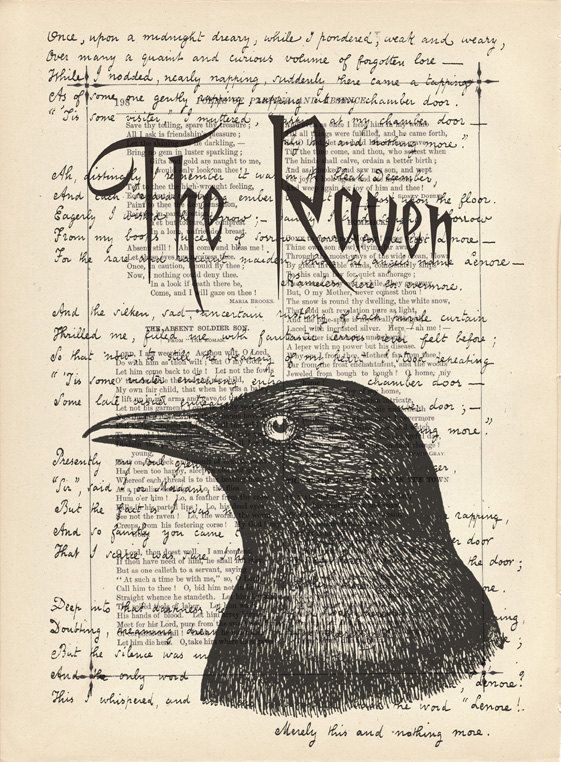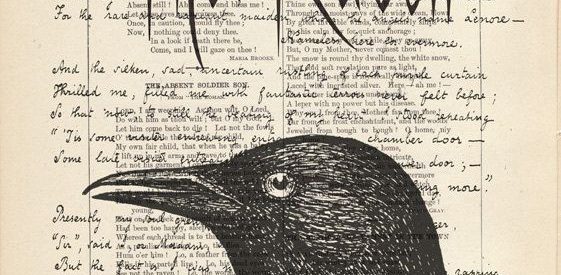How it works, and how Poe used it with consummate mastery
See part one: Rhyming, meter and limericks
When I was studying philosophy in Hamburg I had a dear friend who was doing German and French literature at the University of Tbingen in the south. We started corresponding (letters, written with pens and ink!). Ulrike said she was attending a course on poetry, and that she would like to discuss the subject of rhyming schemes and classical meter in the English poetic tradition with me ? she knew I was a great admirer of Byron, Keats, Longfellow, Browning, and that crowd, as well as Lewis Carroll and his wonderful poems in Alice and elsewhere. ?I would like to discuss the mechanics of these poems with you ?not correspond about the weather,? she wrote. She got a one-page reply which read:
You think that the subject ?bad weather? is weak? Thank heavens we?ve got it! Some people can?t speak about anything else. If it always were gay they?d just sit there staring with nothing to say. The weather in Hamburg last week was just awful. I think they should make it completely unlawful for snow to be falling right now, in November. It?s something I?m sure I cannot remember from previous years, when the sun would shine brightly. That?s so much more pleasant than daily and nightly air temperatures sinking to way below freezing. Nobody finds this in any way pleasing ?
? etc., etc., for a whole page. And ended with the words: ??so although this discussion might seem like a curse, at least as you see it?s inspired me to verse.?
She didn?t see. The reply I got from Ulrike was that she hadn?t fully caught my irony, but that she still seriously wanted to discuss rhyme and meter with me. What had she missed? I?d ask you to guess, but I have pulled this off a number of times and nobody has ever caught me. So I?ll tell you out straight: the whole letter was written in flawless dactylic tetrameter! That is a form of poetry where each line consists of four dactylic feet, with each foot having a stressed syllable followed by two unstressed syllables. Here?s an example by my much admired Browning:
Just for a handful of silver he left us, Just for a riband to stick in his coat ? Found the one gift of which fortune bereft us, Lost all the others she lets us devote?
The tetrameter, I should mention, can have an extra unstressed syllable before the first word of each line, and the rhyme can occur in consecutive or alternating line. So my letter read:
You think that the subject ?bad weather? is weak? Thank heavens we?ve got it. Some people can?t speak?
If you bear the above in mind and reread the passage I quoted from the letter you will see that it is all meticulously executed. I was able to do this for any length of text, one of the talents I have never been able to use for fame or monetary benefit. Only for fun. I think I originally picked up disguised verse from the English priest and writer of detective stories Ronald Knox, who had famously placed the following ad in The Times:
An Anglican curate in want of a second-hand portable font, will exchange for the same a picture (with frame) of the Bishop-Elect of Vermont.
The point is that this is a perfectly constructed limerick (and, the story goes, the Times editors did not catch the spoof).
The other subject of my correspondence with Ulrike was rhyme, which for me was an essential part of great poetry. I could never really fall in love with ?free verse?, which is a form of poetry that does not use regular rhyme or meter patterns. I wrote about this in a previous article, one which was centred around the limerick.
With regard to rhymes, here is one that has been with me all my life. The version from my childhood was that a famous poet was challenged to find a rhyme for ?Timbuktu?, to which he immediately responded:
There was a young priest in Timbuktu.They ate him there, and his himbuktu.
His hymn book too, is the translation. This has been attributed to Gilbert of operatic fame, but that version is more convoluted, and I grew up with mine.
There has been a competition for the shortest poem in the English language. For a long time is was the following, composed by the American poet Strickland Gillilan in the early 20th century:
Fleas: Adam Had ?em.
Ogden Nash, the great humourous poet, set out to beat that:
Maid?s Day Off:Thurs.Hers

Nash, of whom I was always a great fan, was a master of whimsical and often nonsensical verse. He replied to Dorothy Parker?s famous dictum:
Men seldom make passesAt girls who wear glasses
with his own version:
A girl who?s bespectacledMay not get her nectacled
The Nash poem I best remember is this one:
The turtle lives ?twixt plated decksWhich practically conceal its sex. I think it clever of the turtle In such a fix to be so fertile.
And Dorothy on suicidal thoughts:
Razors pain you;Rivers are damp;Acids stain you;And drugs cause cramp.Guns aren?t lawful;Nooses give;Gas smells awful;You might as well live.
One more? Richard Armour was an American poet and author who wrote more than 60 books, mostly humorous, on history, literature, politics. In my teens and early twens I must have read 30 of them. Armour wrote quatrains (four-line humorous poems) in the style of Ogden Nash. Here?s one that has stuck in my mind:
You shake and shake the Ketchup bottle,None?ll comeand then a lottle.
I want to close today?s lecture with a description of the most virtuoso poem ever written in the English language. It was published in 1845 by Edgar Alan Poe and remains to this day one of the best known and most quoted poems in English or possibly any other language.
 Image from Esty.com, where you can find a myriad illustrations of Poe?s poem, many quite haunting.
Image from Esty.com, where you can find a myriad illustrations of Poe?s poem, many quite haunting.
Who doesn?t know the first verse ? on a good day I can recite all 18 stanzas.
Once upon a midnight dreary, while I pondered, weak and weary, Over many a quaint and curious volume of forgotten lore, While I nodded, nearly napping, suddenly there came a tapping, As of some one gently rapping, rapping at my chamber door. ??Tis some visitor,? I muttered, ?tapping at my chamber door ? Only this, and nothing more.?
Already we notice some elements of this poem. It is in trochaic octameter ? eight feet per line, each with one stressed syllable followed by one unstressed syllable: DUM-da DUM-da DUM-da DUM-da, Once upon a midnight dreary, eight times over. There is internal rhyming ? dreary/weary, napping/tapping, while the general rhyme scheme is A-B-C-B. The ninth line of each stanza is a variation of the eighth, and last line is a single tetrameter, half as long as the others. Poe uses this final line of each stanza as a refrain ? probably the most famous in all of literature: Quoth the Raven, ?Nevermore.? It is a B line, and they always rhymes with ?more?.
Synopsis. In the poem we find the narrator trying to forget the death of his beloved Lenore. On a winter night a raven enters his chamber and perches on a bust above the door. The narrator asks the bird for its name, and to his surprise it answers ?Nevermore?. He reasons that this is the only word the raven knows, and it indeed answers every one of his questions with the same word. When he speculates that God may be using the raven to help him forget Lenore, the bird negates that, which means that he will never be free of his memories. When he asks the raven if he will be reunited with Lenore in heaven it again replies ?Nevermore?, which enrages him. He orders it to leave his house, but it ignores him and at the end it ?still is sitting, still is sitting? on the bust above his chamber door. The narrator concludes that his soul will be lifted from the raven?s shadow nevermore.
It is truly a remarkable poem, for instance in it copious use of devices like alliteration (?While I nodded, nearly napping,? or ?Desolate yet all undaunted, on this desert land enchanted, On this home by horror haunted??), and of onomatopoeia. That is the use of words that phonetically resembles the sounds they describe (like sizzle, buzz, meow, cuckoo). Poe?s use of internal rhyming, alliteration and onomatopoeia is superb: And the silken sad uncertain rustling of each purple curtain [onomatopoeia ? you can feel the rustling of the silken curtains], Thrilled me ? filled me with fantastic terrors never felt before [internal rhyme, alliteration].
You can read the poem, perhaps here at the Poetry Foundation (although there are a zillion other places where it is quoted in full). Or you can listen to it being recited on YouTube, for instance by Vincent Price, or more impressively (I feel) by character actor Christopher Lee.

Do not be put off by the few archaic references, like ?Respite ? respite and nepenthe!? or ?Is there ? is there balm in Gilead?? Read it multiple times, or learn it by heart (as I did). It will remain with you for the rest of your life.
Poe was the first American writer to try to earn a living through writing alone, resulting in a financially difficult life and career. For The Raven, on which he had worked for years, he received $9. But it made him an instant nationwide success. Poe is regarded as a central figure of Romanticism in literature and is remembered for his poetry, short stories, tales of mystery and the macabre. He is also considered the inventor of detective stories and the emerging genre of science fiction. There is a postal stamp with his image.

Well, perhaps this little story, set out here in all its glory, will have brought a bit of brightness, and a certain sense of awe. Let us hope that this discussion will awake in you a passion, one which you might well refresh in, after reading Poe?s Lenore. ?It?s a gem,? I hope you mutter, ?like I?ve never seen before.? This I want, and nothing more.
Got it?


